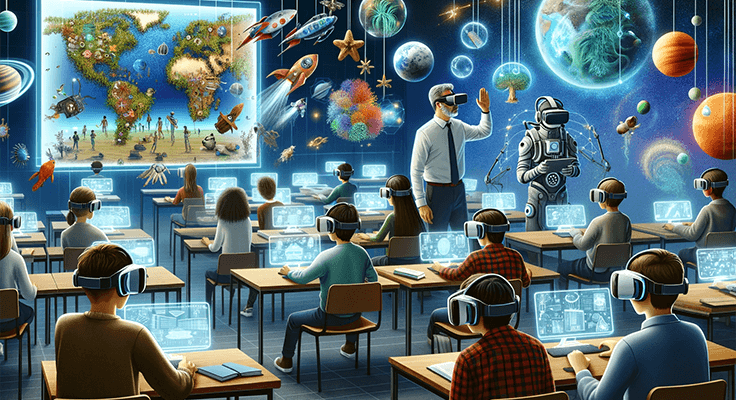
Virtual Reality (VR), one of the latest breakthrough technologies reshaping education, is making waves around the world in classrooms across every subject area. Far beyond gaming and entertainment, VR is becoming an invaluable learning resource. In this blog post we will examine its transformative effect in classroom settings, benefits it brings educators, and how VR fosters an engaging learning experience for its pupils.
Virtual Reality in Education
Virtual Reality has evolved beyond its once futuristic status to become an integral component of education. Thanks to affordable VR headsets and engaging content, teachers can now take students on virtual journeys that provide hands-on, experiential learning approaches spanning subjects like history, geography and biology – taking them back in time, to distant locales or delving deep into microscopic worlds of cells!
Integration of Virtual Reality
One of the primary advantages of using VR in classroom settings is increased student engagement. Traditional teaching methods often fail to capture today’s tech-savvy youth’s interest; VR transforms learning into an engaging experience, making complex concepts accessible and intriguing for all involved.
Immersive Learning
VR sets itself apart from traditional teaching aids by placing its students within an immersive three-dimensional environment that fosters presence and interaction between characters, making the learning experience all the more engaging. VR provides students with an enhanced way of comprehending abstract concepts by providing a spatial context beyond textbooks or flat-screen displays.
Catering to Different Learning Styles
Each student has his or her own learning style, and VR easily accommodates these differences. Visual learners can benefit from vivid and realistic visuals while kinesthetic learners can engage in hands-on activities within the virtual space. With such versatility in place, VR ensures diverse educational needs are addressed more fully resulting in a more inclusive educational experience for all its participants.
Real-World Simulations
VR is an ideal platform for educators to simulate real-life situations, giving their students the chance to apply theoretical knowledge in practical settings. Medical students can practice surgery while engineering students can experiment with building structures all in a safe virtual environment.
Global Connectivity
VR classrooms no longer limit themselves to physical boundaries, enabling students to connect globally through collaborative projects, cultural exchanges and virtual field trips – further broadening their perspective and cultural awareness.
Virtual Reality and Homework Assistance
Technology’s influence is altering the educational landscape, prompting conversations about alternative learning resources to increase. Are you seeking to pay someone to do your homework? When exploring these options, it’s essential to exercise caution and ensure their reliability.
One such service providing homework help is 99papers.com. To select the appropriate service provider for academic support, it is crucial that such reviews be thoroughly conducted; such reviews provide valuable insight into a platform’s reputation, reliability and the quality of assistance it offers students. A comprehensive 99papers.com review can provide information about its platform’s reputation, reliability and the level of assistance it can offer them.
Technology’s Role in Homework Assistance
Technology has changed the way students approach academic responsibilities. Online platforms offering homework assistance utilize this technology to connect students with highly qualified experts, offering them additional resources that enhance their understanding of various subjects.
Students considering such services should carefully consider both benefits and drawbacks before making their decision. While external assistance can be useful, maintaining balance while developing individual problem-solving abilities remains key for academic growth.
Virtual Reality in Education: Prospects for Growth
Virtual Reality in education holds enormous promise. As technology continues to advance, VR applications may become even more sophisticated – catering to an even wider variety of subjects and learning objectives than before. Imagine biology classes where students explore the inner workings of human bodies or literature lessons taking them to classic novels’ settings: there are no limits beyond educators and developers’ imagination!
VR’s increasing accessibility offers educational institutions a powerful solution for closing gaps. Even schools with limited resources can still offer students engaging, immersive learning experiences through cost-effective VR solutions; thus democratizing educational tools and providing equitable access to high-quality educational opportunities for all students from diverse backgrounds.
Careful Integration and Responsible Technology Use
Virtual Reality’s potential benefits in education are undeniable; however, its implementation must be approached carefully and responsibly. Teachers must receive adequate training on how to integrate VR into their teaching methods effectively; furthermore, considerations related to screen time usage, potential health effects, equitable access and any potential access issues should also be addressed to ensure its responsible use in classroom environments.
All in all
Virtual Reality in the classroom can be a revolutionary force, opening up doors to an endless variety of learning possibilities. From improved engagement and immersive learning experiences to global connectivity and global connectivity, VR holds incredible promise to change education as we know it. However, students should use technology carefully when exploring homework assistance platforms such as 99papers.com in order to find reliable resources. By harnessing its potential responsibly both educators and students can start on a journey towards more dynamic and inclusive classroom experiences.





Leave a Reply